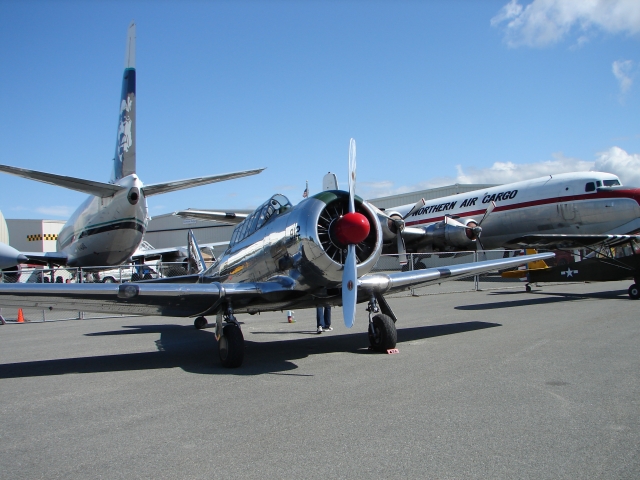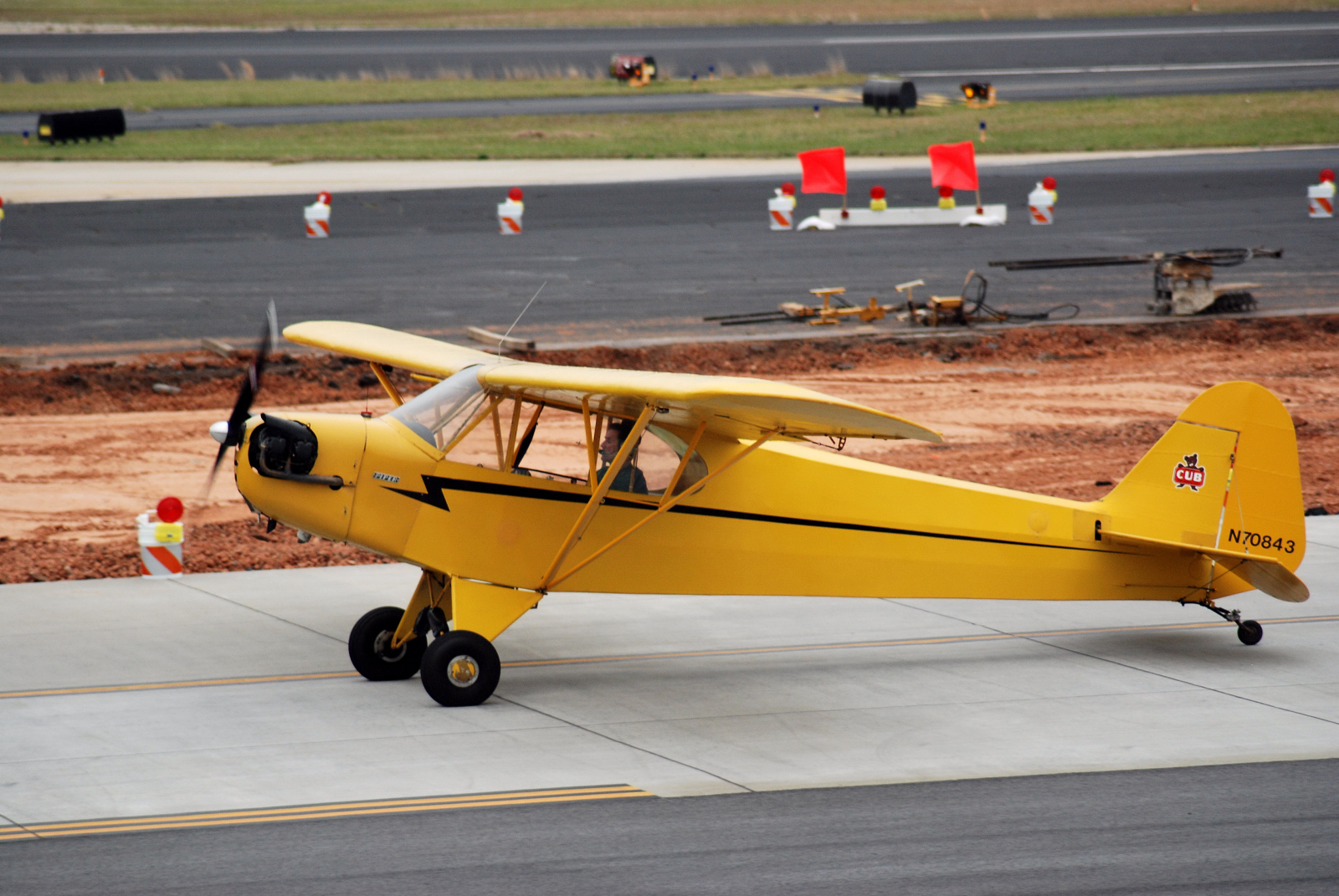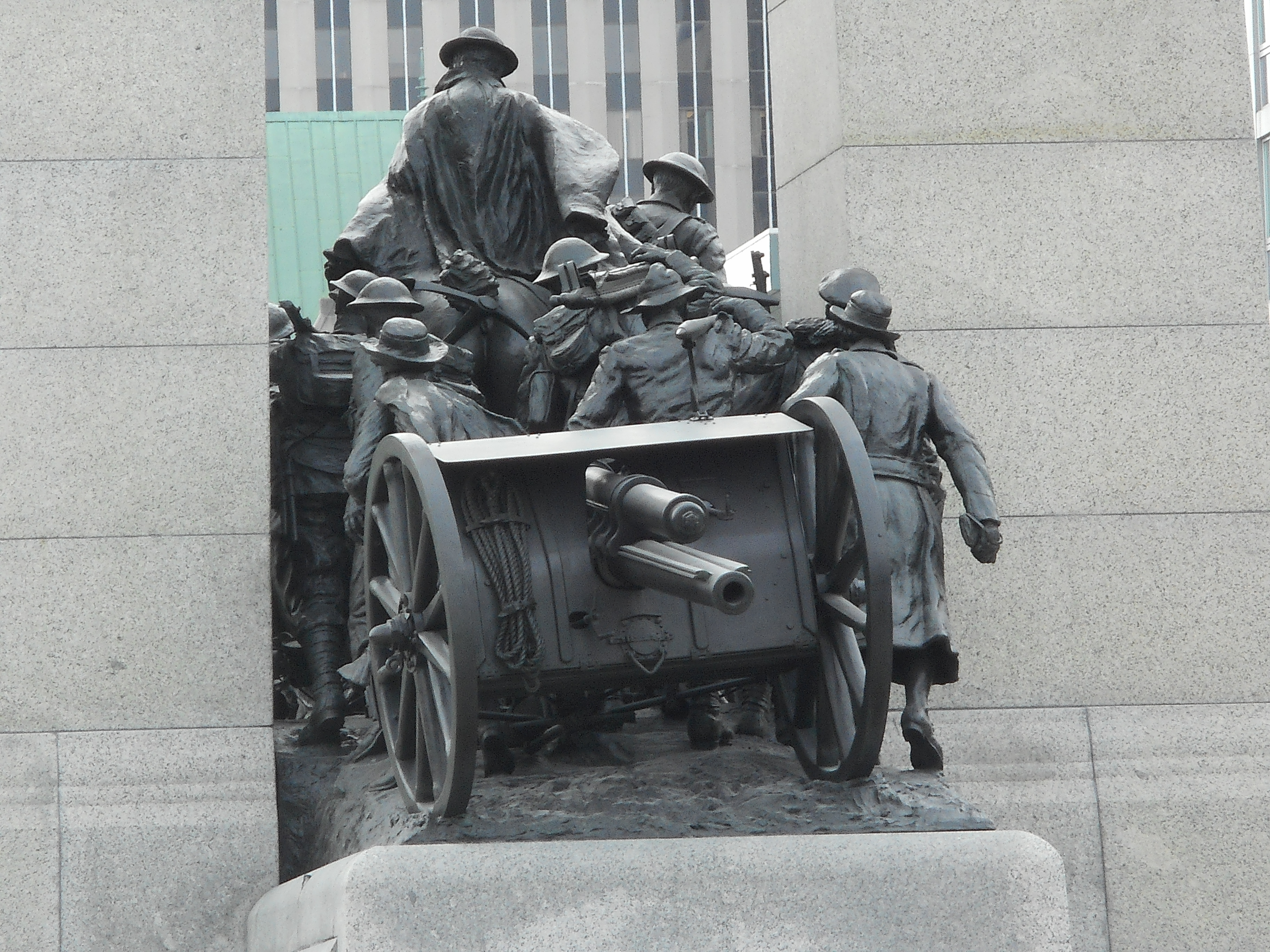|
Vultee L-1 Vigilant
The Stinson L-1 Vigilant (company designation Model 74) is an American liaison aircraft designed by the Stinson Aircraft Company of Wayne, Michigan and manufactured at the Vultee-Stinson factory in Nashville, Tennessee (in August 1940 Stinson became a division of Vultee Aircraft Corporation). The aircraft was operated by the United States Army Air Corps as the O-49 until 1942. Design and development The Vigilant was designed in response to a 1938 United States Army Air Corps design competition for a two-seat light observation aircraft. After the German-manufactured Fieseler Storch was demonstrated at the 4th International Air Meet in Zurich, Switzerland in 1937, the Air Corps Material Division at Wright Field initiated a feasibility study for the creation of a similar aircraft. The development program was approved in January 1938, design and performance specifications were determined in April 1938, and a Circular Proposal for a formal design competition was released to manufactur ... [...More Info...] [...Related Items...] OR: [Wikipedia] [Google] [Baidu] |
WikiProject Aircraft
A WikiProject, or Wikiproject, is a Wikimedia movement affinity group for contributors with shared goals. WikiProjects are prevalent within the largest wiki, Wikipedia, and exist to varying degrees within Wikimedia project, sister projects such as Wiktionary, Wikiquote, Wikidata, and Wikisource. They also exist in different languages, and translation of articles is a form of their collaboration. During the COVID-19 pandemic, CBS News noted the role of Wikipedia's WikiProject Medicine in maintaining the accuracy of articles related to the disease. Another WikiProject that has drawn attention is WikiProject Women Scientists, which was profiled by ''Smithsonian Magazine, Smithsonian'' for its efforts to improve coverage of women scientists which the profile noted had "helped increase the number of female scientists on Wikipedia from around 1,600 to over 5,000". On Wikipedia Some Wikipedia WikiProjects are substantial enough to engage in cooperative activities with outside organization ... [...More Info...] [...Related Items...] OR: [Wikipedia] [Google] [Baidu] |
Stinson L-1
The Stinson L-1 Vigilant (company designation Model 74) is an American liaison aircraft designed by the Stinson Aircraft Company of Wayne, Michigan and manufactured at the Vultee-Stinson factory in Nashville, Tennessee (in August 1940 Stinson became a division of Vultee Aircraft Corporation). The aircraft was operated by the United States Army Air Corps as the O-49 until 1942. Design and development The Vigilant was designed in response to a 1938 United States Army Air Corps design competition for a two-seat light observation aircraft. After the German-manufactured Fieseler Storch was demonstrated at the 4th International Air Meet in Zurich, Switzerland in 1937, the Air Corps Material Division at Wright Field initiated a feasibility study for the creation of a similar aircraft. The development program was approved in January 1938, design and performance specifications were determined in April 1938, and a Circular Proposal for a formal design competition was released to manufactur ... [...More Info...] [...Related Items...] OR: [Wikipedia] [Google] [Baidu] |
Alaska Aviation Heritage Museum
The Alaska Aviation Museum, previously the Alaska Aviation Heritage Museum, is located on Lake Hood Seaplane Base in Anchorage, Alaska. Its mission since 1988, is to preserve, display, and honor Alaska's aviation heritage, by preserving and displaying historic aircraft, artifacts, and memorabilia, and to foster public interest in aviation and its history. The museum has over thirty aircraft on display, a restoration hangar, flight simulators, two theaters, and a Hall of Fame. It provides an emphasis on historic aircraft, aviation artifacts, and memorabilia that contributed to the development and progress of aviation in Alaska, including Bush flying, and the World War II Army base on Adak Island. Overview The museum is made up of the Main, Rasmuson, South, and Restoration Hangars; as well as a shelter. Also on display is the air traffic control tower cab used at Merrill Field from 1962 to 2002. History The Alaskan Historical Aircraft Society was founded in 1977 and the museum open ... [...More Info...] [...Related Items...] OR: [Wikipedia] [Google] [Baidu] |
Polk City, Florida
Polk City is a city in Polk County, Florida, United States. The population was 1,562 at the 2010 census. As of 2018, the population recorded by the U.S. Census Bureau is 2,422. It is part of the Lakeland– Winter Haven Metropolitan Statistical Area. History Polk City was incorporated as a Town in 1925, and changed by ordinance to the City of Polk City in 2005. The city was named after the county, itself named after James Knox Polk, the eleventh president of the United States. Geography According to the United States Census Bureau, the city has a total area of , all land. Polk City is located within the Central Florida Highlands area of the Atlantic coastal plain with a terrain consisting of flatland interspersed with gently rolling hills. Climate Polk City is located in the humid subtropical zone (Köppen climate classification: ''Cfa''). Demographics As of the census of 2000, there were 1,516 people, 542 households, and 422 families residing in the town. The popula ... [...More Info...] [...Related Items...] OR: [Wikipedia] [Google] [Baidu] |
Fantasy Of Flight
Fantasy of Flight is an aviation museum in Polk City, Florida. It opened in November 1995, to house Kermit Weeks' collection of aircraft that, until Hurricane Andrew damaged many in 1992, were housed at the Weeks Air Museum in Tamiami, Florida, On April 6, 2014, it closed to the public, aside from private events and on January 30, 2015, it opened a scaled-down museum displaying a small selection of aircraft while the facility is upgraded for a future reopening. Many of the aircraft displayed are airworthy and some are flown from the facility's grass runways or its seaplane runway. Facility The facility's main buildings consist of the two large "North" and "South" hangars where aircraft are displayed, the restoration shops, an immersion environment, the gift shop, and the Compass Rose, an Art Deco diner. Across from the entrance are a ropes course and zip line amusements. Adjoining the hangars there is a tarmac and two grass runways. On the north side of the runways ar ... [...More Info...] [...Related Items...] OR: [Wikipedia] [Google] [Baidu] |
Stinson 0-49 At Patterson Field During World War II
Stinson may refer to: * Stinson, Ontario * Stinson (surname) *Stinson Aircraft Company * Stinson Lake, in the White Mountains of New Hampshire, in the town of Rumney *Stinson Municipal Airport, San Antonio, Texas * Stinson Theatres, a Canadian movie theatre chain * Stinson Records, an American folk and blues music label *Stinson Beach, California Stinson Beach is an unincorporated community and census-designated place (CDP) in Marin County, California, on the west coast of the United States. Stinson Beach is located east-southeast of Bolinas, at an elevation of . The population of the St ... ** Stinson Beach School ** Stinson Gulch {{disambiguation ... [...More Info...] [...Related Items...] OR: [Wikipedia] [Google] [Baidu] |
Boundary Layer Control
Boundary layer control refers to methods of controlling the behaviour of fluid flow boundary layers. It may be desirable to reduce flow separation on fast vehicles to reduce the size of the wake (streamlining), which may reduce drag. Boundary layer separation is generally undesirable in aircraft high lift coefficient systems and jet engine intakes. Laminar flow produces less skin friction than turbulent but a turbulent boundary layer transfers heat better. Turbulent boundary layers are more resistant to separation. The energy in a boundary layer may need to be increased to keep it attached to its surface. Fresh air can be introduced through slots or mixed in from above. The low momentum layer at the surface can be sucked away through a perforated surface or bled away when it is in a high pressure duct. It can be scooped off completely by a diverter or internal bleed ducting. Its energy can be increased above that of the free stream by introducing high velocity air. Nature Fran ... [...More Info...] [...Related Items...] OR: [Wikipedia] [Google] [Baidu] |
Stinson L-5 Sentinel
The Stinson L-5 Sentinel is a World War II-era liaison aircraft used by the United States Army Air Forces, U.S. Army Ground Forces, U.S. Marine Corps and the British Royal Air Force. It was produced by the Stinson Division of the Vultee Aircraft Company (Consolidated-Vultee from mid-1943). Along with the Stinson L-1 Vigilant, the L-5 was the only other American liaison aircraft that was exclusively built for military use and had no civilian counterpart. Design and development The origins of the L-5 can be traced to the prewar civilian Stinson HW-75. This 75 horsepower civilian high-wing design was built by the Stinson Aircraft Company at Wayne, Michigan and first flew in 1939. It was marketed as the Model 105 and was first introduced to the public at the New York World's Fair. The three-place HW-75 featured two side-by-side seats and a third "jumpseat" in back on which a small passenger could sit facing sideways. Stylish, economical, spin resistant and easy to fly, the plane ... [...More Info...] [...Related Items...] OR: [Wikipedia] [Google] [Baidu] |
Taylorcraft L-2
The Taylorcraft L-2 Grasshopper is an American observation and liaison aircraft built by Taylorcraft for the United States Army Air Forces in World War II. Design and development In 1941 the United States Army Air Forces ordered four Taylorcraft Ds with the designation YO-57. They were evaluated in the summer of 1941 during maneuvers in Louisiana and Texas where they were used for support purposes such as light transport and courier. General Innis P. Swift, commander of the 1st Cavalry Division, coined the 'grasshopper' name after witnessing a bumpy landing. This led to a production order under the designation O-57 Grasshopper. In March 1942, the designation was changed to L-2 Grasshopper. In World War II, the AAF began using the L-2 in much the same manner as the observation balloon was used in France during World War I—spotting enemy troop and supply concentrations and directing artillery fire on them. It was also used for other types of liaison and transport duties and ... [...More Info...] [...Related Items...] OR: [Wikipedia] [Google] [Baidu] |
Aeronca L-3
The Aeronca L-3 group of observation and liaison aircraft were used by the United States Army Air Corps in World War II. The L-3 series were adapted from Aeronca's pre-war Tandem Trainer and Chief models. Design and development In 1941, the United States Army Air Corps ordered four examples of the Aeronca 65 TC Defender, designated YO-58, for evaluation of the suitability of light aircraft for observation and liaison purposes. (It also placed similar orders with Piper and Taylorcraft Aircraft). Service tests during the US Army's annual maneuvers proved successful, and resulted in large orders being placed. In 1942, the O-58 was redesignated L-3.Swanborough and Bowers 1963, p. 31.Mondey 1996, p. 8. When American forces went into combat after Pearl Harbor, the Army Air Force used the L-3 in much the same manner as observation balloons were used during World War I—spotting activities and directing artillery fire. It was also used for liaison and transport duties and sho ... [...More Info...] [...Related Items...] OR: [Wikipedia] [Google] [Baidu] |
Piper J-3
The Piper J-3 Cub is an American light aircraft that was built between 1938 and 1947 by Piper Aircraft. The aircraft has a simple, lightweight design which gives it good low-speed handling properties and short-field performance. The Cub is Piper Aircraft's most-produced model, with nearly 20,000 built in the United States. Its simplicity, affordability and popularity invokes comparisons to the Ford Model T automobile. The aircraft is a high-wing, strut-braced monoplane with a large-area rectangular wing. It is most often powered by an air-cooled, flat-4 piston engine driving a fixed-pitch propeller. Its fuselage is a welded steel frame covered in fabric, seating two people in tandem. The Cub was designed as a trainer. It had great popularity in this role and as a general aviation aircraft. Due to its performance, it was well suited for a variety of military uses such as reconnaissance, liaison and ground control. It was produced in large numbers during World War II as the ... [...More Info...] [...Related Items...] OR: [Wikipedia] [Google] [Baidu] |
Harry Crerar
General Henry Duncan Graham Crerar (28 April 1888 – 1 April 1965) was a senior officer of the Canadian Army who became the country's senior field commander in the Second World War as commander of the First Canadian Army in the campaign in North West Europe in 1944–1945. A graduate of the Royal Military College of Canada, in Kingston, Ontario, Crerar was commissioned as a lieutenant in the Non-Permanent Active Militia in 1909, serving with the 4th Battery, Canadian Field Artillery, which was based in Hamilton, Ontario. He rose to the rank of lieutenant-colonel in the artillery in the First World War, during which he was mentioned in despatches and made a member of the Distinguished Service Order (DSO). Electing to remain in the army as a professional soldier after the war, he attended the Staff College, Camberley, from 1923 to 1924, and the Imperial Defence College in 1934. He was appointed Director of Military Operations & Military Intelligence in 1935 and Commandant of the ... [...More Info...] [...Related Items...] OR: [Wikipedia] [Google] [Baidu] |






.jpg)

